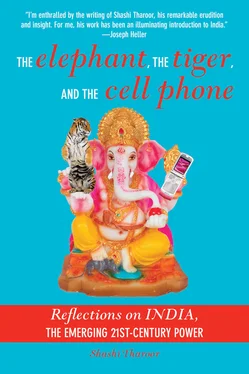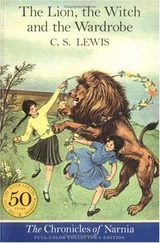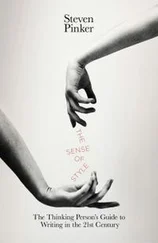In another part of the jungle, to the southeast, another group of animals was faring much better than our elephant. They were a sleek band of tigers, their stripes glistening in the sun that seemed inevitably to shine on their patch of forest. The tigers were lithe and well muscled; they ate well, they bounded about, and they grew strong and contented. Though tourists still came occasionally to photograph the elephant, the tigers attracted swarms of visitors, who took pictures and films that framed the tigers’ fearful symmetry. The visitors also gushed about the greenness of the grass the tigers grazed on, brought them ever more food and water, and stroked their backs till their coats glittered. If the elephant noticed what was going on, she pretended not to; far from wondering what shoulder and what art might have twisted the sinews of the tigers’ heart, she acted as if the good fortune of such small, little creatures was of no consequence for an animal as large and important as an elephant.
But then, one day, she fell ill. She lay down and bellowed, until the veterinarians from the big animal hospital came running to see what the matter was. And when they had examined her, they told her the sad truth: either she would have to change the way she was living, allow others into her patch of jungle, and pay attention to the needs of the other animals (needs she could help them fulfill), or she would soon have to sell her tusks to be made into ivory trophies for the mantels of distant humans. “My tusks?!” she exclaimed in consternation (and horror). “I'll never sell my tusks!”
“Why, then,” the vets said, “you must change. You must become more like the tigers.”
The elephant blanched (which looked particularly awful under the gray pallor of her mottled skin), but said nothing. She lumbered heavily to her feet and plodded uncertainly toward her new destiny. Slowly, very slowly, but with the deliberateness for which she was known, she began to change.
As the seasons passed, the other animals began to notice that there was something different about the old elephant. She brushed off the fleas that had begun feasting on her. A certain sprightliness entered her step. She still moved with that familiar elephantine gait, but there was a pronounced sway from side to side now, as though she were prepared to entertain all possibilities. The old fat began to give way to muscle. Her ears flapped in a way that suggested she was — surprise! — actually listening, instead of merely lecturing others. She dipped her trunk into clean water and sprayed it liberally on herself, washing away decades of dirt and mud (though some clumps still stubbornly clung to her). She began to grow — how she began to grow! Soon the visitors started crossing over from the tigers’ sanctuary to take a look. And they started chattering to one another in excitement, since they could not believe what they were seeing. For, appearing on the elephant's back, at first faint but soon clearly visible, was the unmistakable sign of stripes. Large black stripes swirled confidently around her torso. And then, even as the visitors gawked with disbelief, the elephant's dirty gray skin began to acquire a distinctly golden hue.
There was no doubt about it. The elephant was becoming a tiger.
Miracle of miracles! All the animals came to look, and admire. Some were afraid: imagine the strength of a tiger within the size of an elephant! What would happen to the rest of the jungle? Others said there was no reason to worry: whatever stripes she grew, the elephant would always be an elephant at heart. And still others said, it can't last; the stripes will fade away soon enough, and we will again see the comforting sight of our old plodding, stumbling friend.
Which of the animals would be right? Who knows? Tune in a few years from now, when we will recount the next episode of our favorite animal fable.
1. The Invention of India
IN A PASSAGE OF HIS MUCH-MISUNDERSTOOD NOVEL The Satanic Verses, Salman Rushdie writes of “the eclectic, hybridized nature of the Indian artistic tradition.” Under the Mughals, he says, artists of different faiths and traditions were brought from many parts of India to work on a painting. One hand would paint the mosaic floors, another the human figures, a third the cloudy skies: “Individual identity was submerged to create a many-headed, many-brushed Overartist who, literally, was Indian painting.”
This evocative image could as well be applied to the very idea of India, itself the product of the same hybrid culture. How, after all, can one approach this land of snow peaks and tropical jungles, with twenty-three major languages and 22,000 distinct dialects (including some spoken by more people than Danish or Norwegian), inhabited in the first years of the twenty-first century by a billion individuals of every ethnic extraction known to humanity? How does one come to terms with a country whose population is 40 percent illiterate but which has educated the world's second-largest pool of trained scientists and engineers, whose teeming cities overflow while two out of three Indians still scratch a living from the soil? What is the clue to understanding a country rife with despair and disrepair, which nonetheless moved a Mughal emperor to declaim, “If on earth there be paradise of bliss, it is this, it is this, it is this”? How does one gauge a culture that elevated nonviolence to an effective moral principle, but whose freedom was born in blood and whose independence still soaks in it? How does one explain a land where peasant organizations and suspicious officials attempt to close down Kentucky Fried Chicken™ as a threat to the nation, where a former prime minister bitterly criticizes the sale of Pepsi-Cola™ “in a country where villagers don't have clean drinking water,” and yet invents more sophisticated software for U.S. computer manufacturers than any other country in the world? How can one portray an ageless civilization that was the birthplace of four major religions, a dozen different traditions of classical dance, eighty-five political parties, and three hundred ways of cooking the potato?
The short answer is that it can't be done — at least not to everyone's satisfaction. Any truism about India can be immediately contradicted by another truism about India. The country's national motto, emblazoned on its governmental crest, is “Satyameva Jayaté” —Truth alone triumphs. The question remains, however, whose truth? It is a question to which there are at least a billion answers — if the last census hasn't undercounted us again.
For the singular thing about India, as I have written elsewhere, is that you can only speak of it in the plural. There are, in the hackneyed phrase, many Indias. If India were to adopt the well-known U.S. motto, it would have read “ E Pluribis Pluribum .” Everything exists in countless variants. There is no single standard, no fixed stereotype, no “one way.” This pluralism is acknowledged in the way India arranges its own affairs: all groups, faiths, tastes, and ideologies survive and contend for their place in the sun. The idea of India is that of a land emerging from an ancient civilization, united by a shared history, sustained by pluralist democracy, but containing a world of differences. It is not surprising, then, that the political life of modern India has been rather like traditional Indian music: the broad basic rules are firmly set, but within them one is free to improvise, unshackled by a written score.
When India celebrated the forty-ninth anniversary of its independence from British rule in 1996, our then — prime minister, H. D. Deve Gowda, stood at the ramparts of Delhi's sixteenth-century red fort and delivered the traditional Independence Day address to the nation in Hindi, India's national language. Eight other prime ministers had done exactly the same thing forty-eight times before him, but what was unusual this time was that Deve Gowda, a southerner from the state of Karnataka, spoke to the country in a language of which he did not know a word. Tradition and politics required a speech in Hindi, so he gave one — the words having been written out for him in his native Kannada script, in which they, of course, made no sense.
Читать дальше












